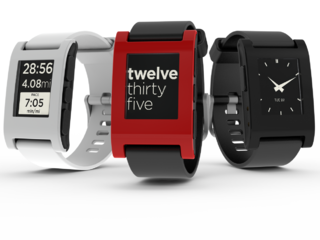Related Research Articles
A mobile operating system is an operating system for smartphones, tablets, smartwatches, smartglasses, or other non-laptop personal mobile computing devices. While computers such as typical/mobile laptops are "mobile", the operating systems used on them are generally not considered mobile ones, as they were originally designed for desktop computers that historically did not have or need specific mobile features. This line distinguishing mobile and other forms has become blurred in recent years, due to the fact that newer devices have become smaller and more mobile unlike hardware of the past. Key notabilities blurring this line are the introduction of tablet computers and light-weight laptops and the hybridization of the two in 2-in-1 PCs.

A smartwatch is a wearable computer in the form of a watch; modern smartwatches provide a local touchscreen interface for daily use, while an associated smartphone app provides management and telemetry, such as long-term biomonitoring. While early models could perform basic tasks, such as calculations, digital time telling, translations, and game-playing, smartwatches released since 2015 have more general functionality closer to smartphones, including mobile apps, a mobile operating system and WiFi/Bluetooth connectivity. Some smartwatches function as portable media players, with FM radio and playback of digital audio and video files via a Bluetooth headset. Some models, called watch phones, have mobile cellular functionality such as making telephone calls.

Pebble is a discontinued smartwatch developed by Pebble Technology Corporation. Funding was conducted through a Kickstarter campaign running from April 11, 2012, to May 18, 2012, which raised $10.3 million; it was the most funded project in Kickstarter history, at the time. Pebble began shipping watches to Kickstarter backers in January 2013. Pebble watches can be connected to Android and iOS devices to show notifications and messages. An online app store distributed Pebble-compatible apps from many developers including ESPN, Uber, Runkeeper, and GoPro.
The HTC Rhyme is a multi-touch, slate-format Android 2.3 smartphone designed and produced by HTC. The Rhyme was released in the United States exclusively by Verizon Wireless on September 22, 2011, with releases in Asia and Europe beginning in October 2011. The Rhyme is a mid-range smartphone, distinguished by its use of an updated HTC Sense 3.5 user experience, and a selection of bundled accessories; such as a charging dock, wireless speakers, and an LED "charm" that can be used as a notification light. While it was not explicitly marketed as such by HTC, the Rhyme was primarily developed and targeted towards women.

The Samsung Galaxy Gear is a smartwatch produced by Samsung Electronics in the Samsung Gear family of devices. Unveiled during a Samsung Unpacked event in Berlin, Germany on September 4, 2013, the device serves as a companion for all Samsung Galaxy smartphones and tablets which runs on Android 4.3 "Jelly Bean" or newer. It was released on September 25, 2013. Originally released as an Android-based device, Samsung replaced the operating system with Tizen through the May 2014 software update.

The Samsung Gear 2 and Samsung Gear 2 Neo are smartwatches produced by Samsung Electronics. Unveiled on February 22, 2014 at Mobile World Congress, the Gear 2 line is a successor to the Samsung Galaxy Gear.

Wear OS is a version of Google's Android operating system designed for smartwatches and other wearables. By pairing with mobile phones running Android version 6.0 "Marshmallow" or newer, or iOS version 10.0 or newer with limited support from Google's pairing application, Wear OS integrates Google Assistant technology and mobile notifications into a smartwatch form factor.

The Moto 360 is an Android Wear-based smartwatch announced by Motorola Mobility in 2014. It was announced on March 18, 2014 and was released on September 5, 2014 in the US along with new models of the Moto X and the Moto G.

Misfit, Inc. was an American consumer electronics company founded on 14 October 2011 by Sonny Vu, Sridhar Iyengar and John Sculley, owned by Fossil Group. It specialized in wearable technology that utilizes sensors and home automation products. Misfit's wearable activity trackers and count sleep, calories, and basic steps that can be synced to a mobile app on a compatible smartphone. Vu and Iyengar previously co-founded AgaMatrix, a company that made the iBGStar, the first FDA approved Smartphone medical device.

Android Lollipop is the fifth major version of the Android mobile operating system developed by Google and the 12th version of Android, spanning versions between 5.0 and 5.1.1. Unveiled on June 25, 2014 at the Google I/O 2014 conference, it became available through official over-the-air (OTA) updates on November 12, 2014, for select devices that run distributions of Android serviced by Google. Its source code was made available on November 3, 2014. The first phone with Android Lollipop was the Nexus 6.

The Apple Watch is a line of smartwatches produced by Apple Inc. It incorporates fitness tracking, health-oriented capabilities, and wireless telecommunication, and integrates with iOS and other Apple products and services. The Apple Watch was released in April 2015, and quickly became the best-selling wearable device: 4.2 million were sold in the second quarter of fiscal 2015, and more than 115 million people were estimated to use an Apple Watch as of December 2022. Apple has introduced a new generation of the Apple Watch with improved internal components each September—each labeled by Apple as a 'Series', with certain exceptions.

Microsoft Band is a discontinued smart band with smartwatch and activity tracker/fitness tracker features, created and developed by Microsoft. It was announced on October 29, 2014. The Microsoft Band incorporates fitness tracking and health-oriented capabilities and integrated with Windows Phone, iOS, and Android smartphones through a Bluetooth connection. On October 3, 2016, Microsoft stopped sales and development of the line of devices. On May 31, 2019, the Band's companion app was decommissioned, and Microsoft offered a refund for customers who were lifelong active platform users.

Pebble Time is a discontinued smartwatch developed by Pebble Technology and assembled by Foxlink, released on 14 May 2015. This is the first Pebble to introduce a color e-paper display, as well as a microphone, a new charging cable and a new Pebble Time-optimized operating system.

The Huawei Watch, an Android Wear–based smartwatch developed by Huawei, was announced at the 2015 Mobile World Congress on March 1, 2015. It was the first smart watch produced by Huawei,and released at Internationale Funkausstellung Berlin on September 2, 2015.
The Moto 360 , also known as the Moto 360 (2015), is an Android Wear-based smartwatch. It was announced on September 14, 2015 at the IFA.

Android Oreo is the eighth major release and the 15th version of the Android mobile operating system. It was first released as an alpha quality developer preview in March 2017 and released to the public on August 21, 2017.

The Samsung Galaxy Fit is an activity tracker designed, developed, and marketed by Samsung Electronics. It was released on 20 February 2019, along with the lower-priced Galaxy Fit e. It was made available for sale on June 14, 2019.
The Pixel Watch is a Wear OS smartwatch designed, developed, and marketed by Google as part of the Google Pixel product line. First previewed in May 2022 during the Google I/O keynote, it features a round dome-shaped display as well as heavy integration with Fitbit, which Google acquired in 2021. Two Pixel-branded smartwatches had been in development at Google by July 2016, but they were canceled ahead of their release due to hardware chief Rick Osterloh's concerns that they did not fit well with other Pixel devices. Development on a new Pixel-branded watch began shortly after Google's acquisition of Fitbit.
References
- ↑ i'm S.p.A. exits from the market of "Wearable Technology". Press Release from i'm S.p.A.
- ↑ i'm Watch Review: A smartwatch that's not quite intelligent enough", CNET. Bennett, Brian. Retrieved 19 February 2014.
- ↑ i'm Watch Review Laptop Magazine. Piltch, Avram. Retrieved 19 February 2014.
- ↑ i'm Watch Review Tech Radar. Carter, Jaime. Retrieved 19 February 2014.